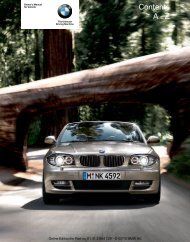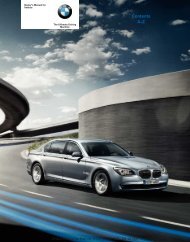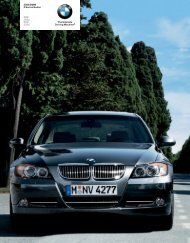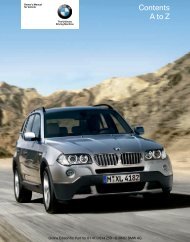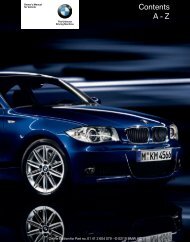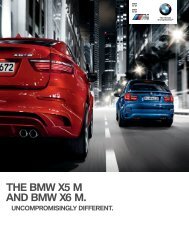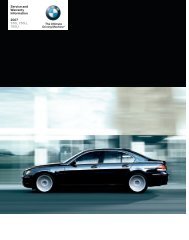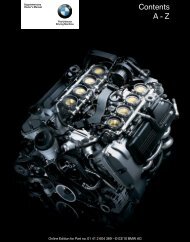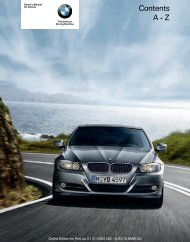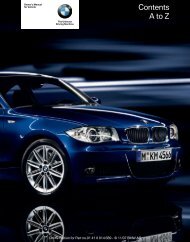2011 3 Series Owner's Manual without iDrive - Irvine BMW
2011 3 Series Owner's Manual without iDrive - Irvine BMW
2011 3 Series Owner's Manual without iDrive - Irvine BMW
Create successful ePaper yourself
Turn your PDF publications into a flip-book with our unique Google optimized e-Paper software.
Wheels and tires<br />
Tire identification marks<br />
Knowledge of the labeling on the side of the tire<br />
makes it easier to identify and choose the right<br />
tires.<br />
Tire size<br />
e.g.<br />
Nominal width in mm<br />
Aspect ratio in Ξ<br />
225/45 R 17 91 V<br />
Radial belt construction<br />
Rim diameter in inches<br />
Load rating,<br />
not on ZR tires<br />
Speed code letter, in<br />
front of the R on ZR tires<br />
Speed code letter<br />
Q = up to 100 mph or 160 km/h<br />
T = up to 118 mph or 190 km/h<br />
H = up to 131 mph or 210 km/h<br />
V = up to 150 mph or 240 km/h<br />
W = up to 167 mph or 270 km/h<br />
Y = up to 186 mph or 300 km/h<br />
Tire Identification Number<br />
Tires with DOT codes meet the guidelines of<br />
the US Department of Transportation.<br />
DOT code:<br />
e.g.<br />
DOT xxxx xxx 1010<br />
Manufacturer's<br />
code for tire make<br />
Tire size and<br />
tire design<br />
Tire age<br />
Tire age<br />
The manufacturing date of tires is contained in<br />
the tire coding: DOT … 1010 means that the<br />
tire was manufactured in week 10 of 2010.<br />
<strong>BMW</strong> recommends that you replace all tires<br />
after 6 years at most, even if some tires may<br />
last for 10 years.<br />
Uniform Tire Quality Grading<br />
Quality grades can be found where applicable<br />
on the tire sidewall between tread shoulder and<br />
maximum section width. For example:<br />
Tread wear 200 Traction AA<br />
Temperature A<br />
DOT Quality Grades<br />
Tread wear<br />
Traction AA A B C<br />
Temperature A B C<br />
All passenger car tires must conform to<br />
Federal Safety Requirements in addition<br />
to these grades.<<br />
Tread wear<br />
The tread wear grade is a comparative rating<br />
based on the wear rate of the tire when tested<br />
under controlled conditions on a specified government<br />
test course. For example, a tire graded<br />
150 would wear one and one-half (1γ) times as<br />
well on the government course as a tire graded<br />
100. The relative performance of tires depends<br />
upon the actual conditions of their use, however,<br />
and may depart significantly from the<br />
norm due to variations in driving habits, service<br />
practices and differences in road characteristics<br />
and climate.<br />
Traction<br />
The traction grades, from highest to lowest,<br />
are AA, A, B, and C.<br />
Those grades represent the tire's ability to stop<br />
on wet pavement as measured under controlled<br />
conditions on specified government test surfaces<br />
of asphalt and concrete. A tire marked C<br />
may have poor traction performance.<br />
The traction grade assigned to this tire is<br />
based on straight-ahead braking traction<br />
tests, and does not include acceleration, cornering,<br />
hydroplaning, or peak traction characteristics.<<br />
140



